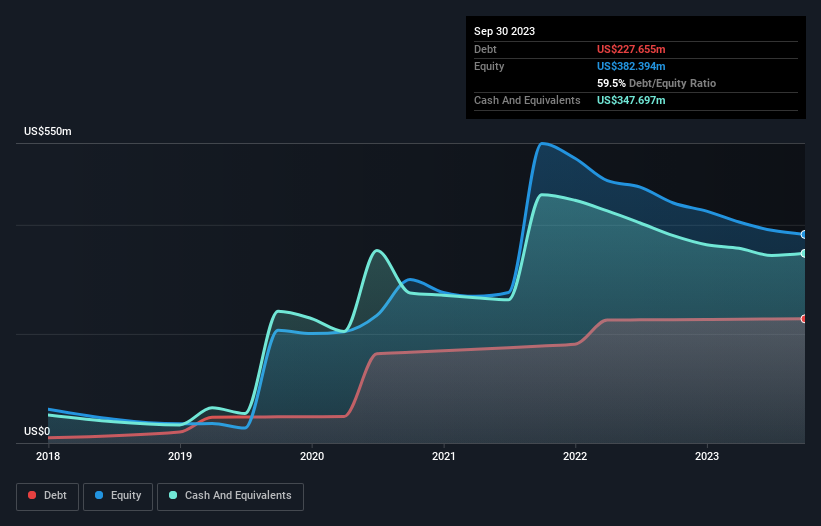Some say volatility, rather than debt, is the best way to think about risk as an investor, but Warren Buffett famously said that 'Volatility is far from synonymous with risk.' So it seems the smart money knows that debt - which is usually involved in bankruptcies - is a very important factor, when you assess how risky a company is. As with many other companies Health Catalyst, Inc. (NASDAQ:HCAT) makes use of debt. But the more important question is: how much risk is that debt creating?
When Is Debt A Problem?
Generally speaking, debt only becomes a real problem when a company can't easily pay it off, either by raising capital or with its own cash flow. If things get really bad, the lenders can take control of the business. However, a more common (but still painful) scenario is that it has to raise new equity capital at a low price, thus permanently diluting shareholders. Of course, the upside of debt is that it often represents cheap capital, especially when it replaces dilution in a company with the ability to reinvest at high rates of return. The first step when considering a company's debt levels is to consider its cash and debt together.
See our latest analysis for Health Catalyst
How Much Debt Does Health Catalyst Carry?
As you can see below, Health Catalyst had US$227.7m of debt, at September 2023, which is about the same as the year before. You can click the chart for greater detail. But on the other hand it also has US$347.7m in cash, leading to a US$120.0m net cash position.

How Strong Is Health Catalyst's Balance Sheet?
The latest balance sheet data shows that Health Catalyst had liabilities of US$84.3m due within a year, and liabilities of US$246.3m falling due after that. Offsetting this, it had US$347.7m in cash and US$46.7m in receivables that were due within 12 months. So it can boast US$63.9m more liquid assets than total liabilities.
This short term liquidity is a sign that Health Catalyst could probably pay off its debt with ease, as its balance sheet is far from stretched. Simply put, the fact that Health Catalyst has more cash than debt is arguably a good indication that it can manage its debt safely. There's no doubt that we learn most about debt from the balance sheet. But ultimately the future profitability of the business will decide if Health Catalyst can strengthen its balance sheet over time. So if you're focused on the future you can check out this free report showing analyst profit forecasts.
In the last year Health Catalyst wasn't profitable at an EBIT level, but managed to grow its revenue by 6.7%, to US$290m. We usually like to see faster growth from unprofitable companies, but each to their own.
So How Risky Is Health Catalyst?
We have no doubt that loss making companies are, in general, riskier than profitable ones. And in the last year Health Catalyst had an earnings before interest and tax (EBIT) loss, truth be told. Indeed, in that time it burnt through US$44m of cash and made a loss of US$124m. While this does make the company a bit risky, it's important to remember it has net cash of US$120.0m. That means it could keep spending at its current rate for more than two years. Even though its balance sheet seems sufficiently liquid, debt always makes us a little nervous if a company doesn't produce free cash flow regularly. There's no doubt that we learn most about debt from the balance sheet. But ultimately, every company can contain risks that exist outside of the balance sheet. To that end, you should be aware of the 2 warning signs we've spotted with Health Catalyst .
If you're interested in investing in businesses that can grow profits without the burden of debt, then check out this free list of growing businesses that have net cash on the balance sheet.
Valuation is complex, but we're here to simplify it.
Discover if Health Catalyst might be undervalued or overvalued with our detailed analysis, featuring fair value estimates, potential risks, dividends, insider trades, and its financial condition.
Access Free AnalysisHave feedback on this article? Concerned about the content? Get in touch with us directly. Alternatively, email editorial-team (at) simplywallst.com.
This article by Simply Wall St is general in nature. We provide commentary based on historical data and analyst forecasts only using an unbiased methodology and our articles are not intended to be financial advice. It does not constitute a recommendation to buy or sell any stock, and does not take account of your objectives, or your financial situation. We aim to bring you long-term focused analysis driven by fundamental data. Note that our analysis may not factor in the latest price-sensitive company announcements or qualitative material. Simply Wall St has no position in any stocks mentioned.
About NasdaqGS:HCAT
Health Catalyst
Provides data and analytics technology and services to healthcare organizations in the United States.
Flawless balance sheet with low risk.
Similar Companies
Market Insights
Community Narratives




